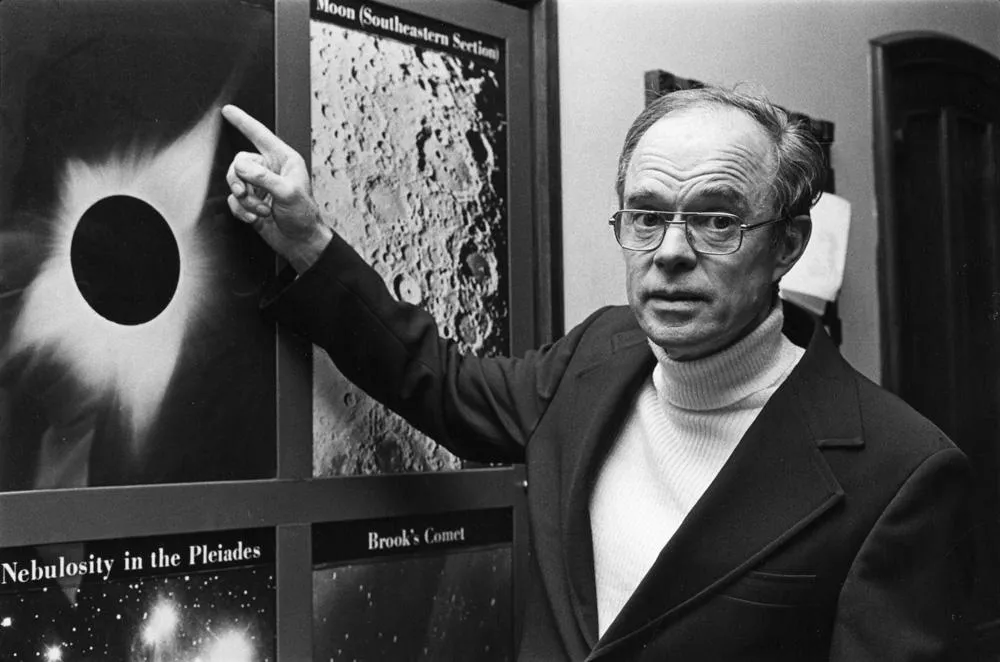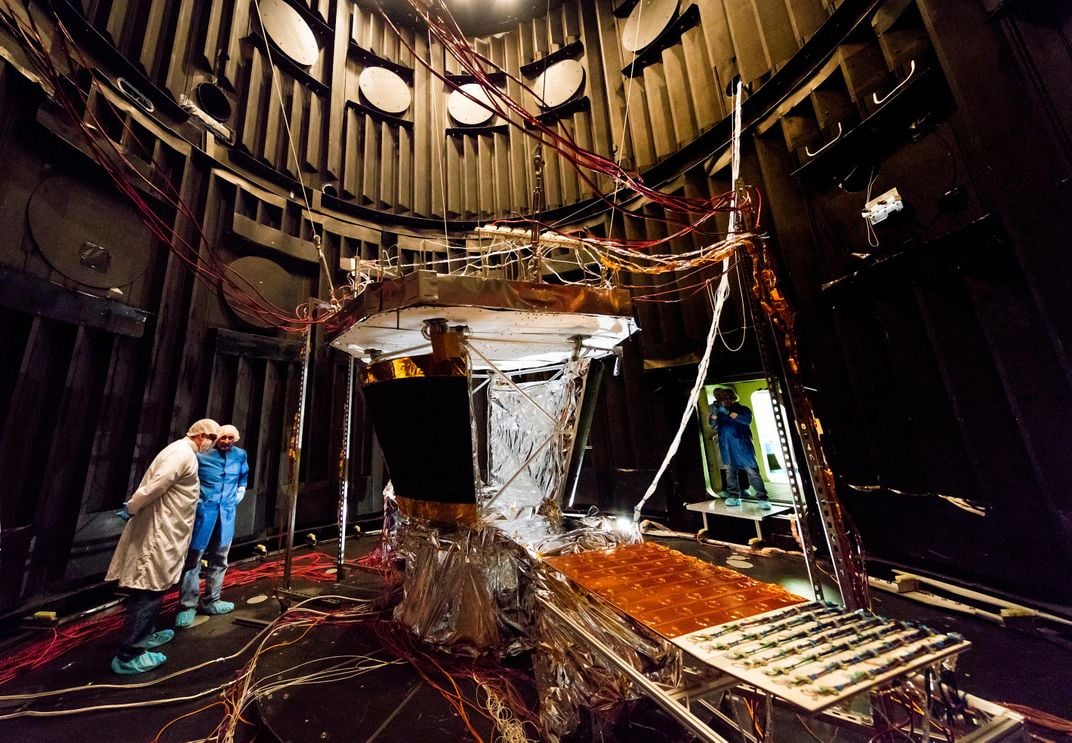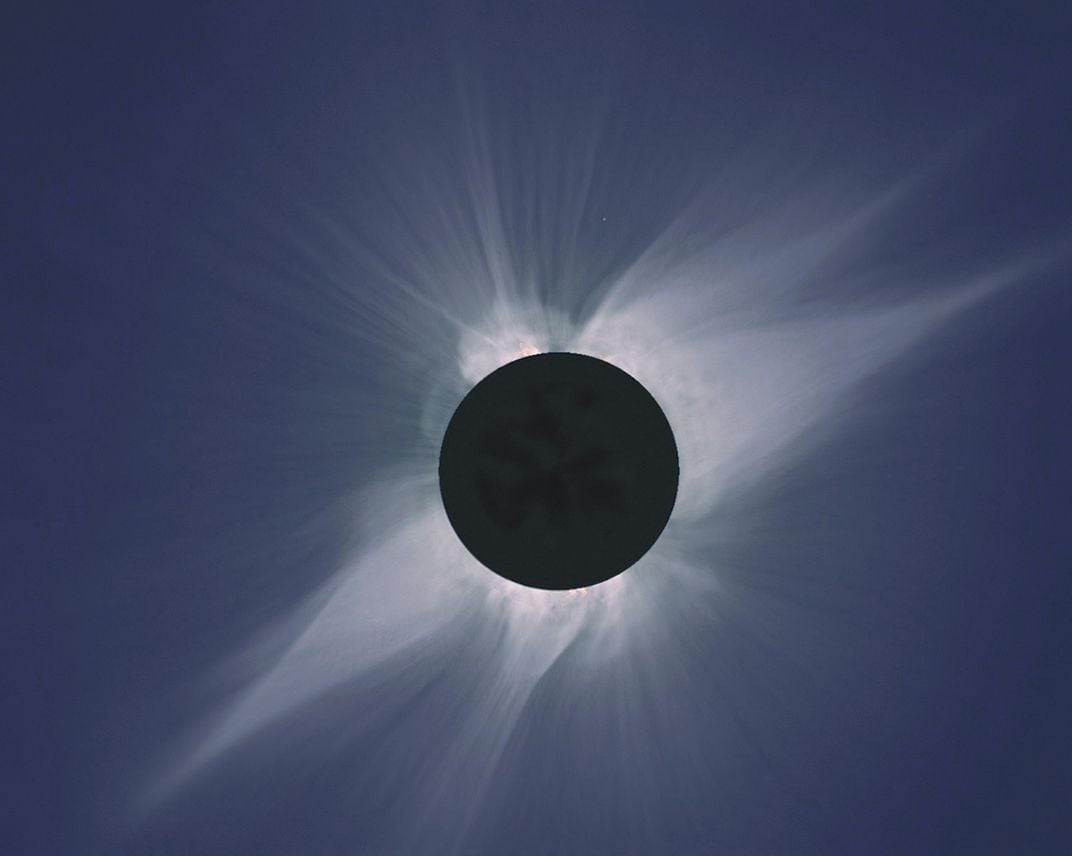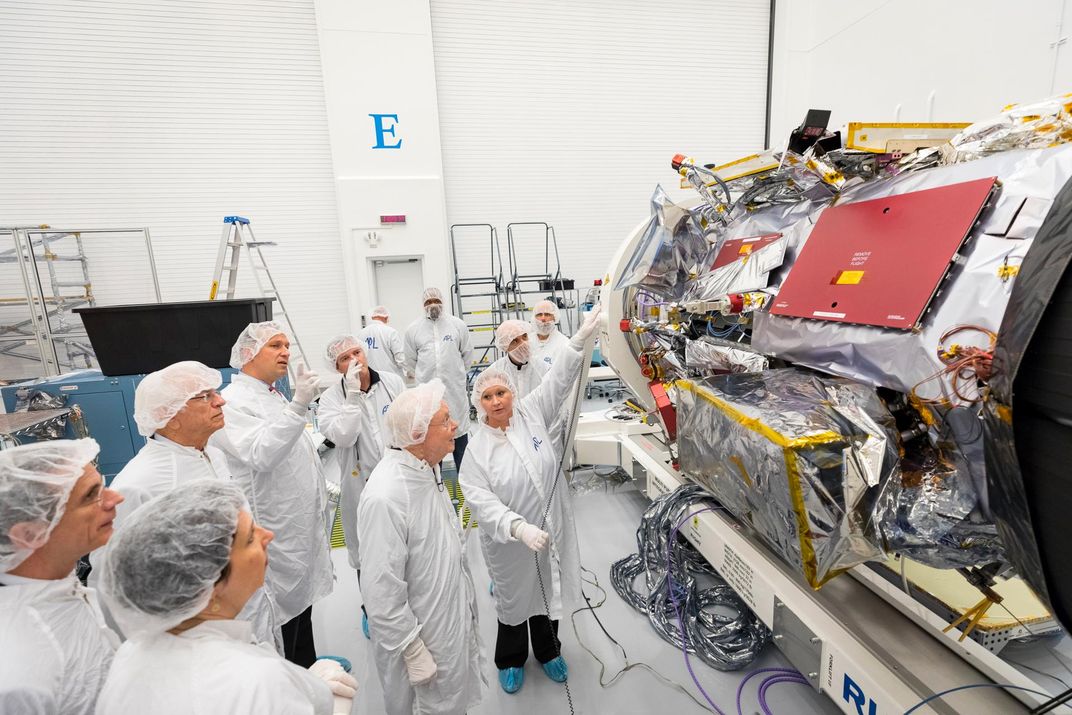Eugene Parker’s Journey to the Sun
He coined the term “solar wind.” Now a spacecraft will brave its source.
/https://tf-cmsv2-smithsonianmag-media.s3.amazonaws.com/filer/a0/5d/a05dbefe-900b-4458-ba61-ef51b3021c43/171_5days.jpg)
In July, humanity will dispatch its first emissary to our star. [Update: The launch has been rescheduled for August 11.] A Delta IV Heavy rocket with an added upper stage will boost NASA’s Parker Solar Probe away from Earth and, whipped by Venus’ gravity, it will soon become the fastest spacecraft ever flown. At its top speed, the spacecraft will scream through space at 430,000 mph, fast enough to travel from New York to Los Angeles in 25 seconds.
During seven years of carefully choreographed swoops, it will draw closer to the sun, like a matador dancing inward toward a glowering bull. It will ultimately settle into an elliptical orbit that, at perihelion, comes within 3.9 million miles of the sun’s visible surface, more than seven times closer than any spacecraft has dared venture. It will not touch the surface. That would be too dangerous—and impossible, because the sun is a roiling furnace of plasma, a state of matter unable to form what could be considered a surface. Instead, the probe will fly directly into the only region of the solar system so far unexplored by spacecraft: the corona. What happens here, in the sun’s atmosphere stretching out millions of miles, affects this planet and every other place in our neighborhood, but its dynamics remain mysterious.
We know that the sun’s atmosphere is much hotter than its outer plasma layer, a fact that seems to defy thermodynamics. Solar wind from the corona drifts outward, crossing 93 million miles of space to create the aurora in Earth’s magnetosphere. From Earth, we can’t see the corona, unless we watch during a total solar eclipse. The Parker Solar Probe will sample this layer of the sun directly, and for the first time we will be able to retrieve information about the realm that connects Earth and our star.
**********
Comet tails were the first evidence that the sun was more than a static ball in the sky. In 1607, an apparition appeared at night: a comet that would eventually be named after Edmond Halley, the astronomer who predicted its 75-year orbit. German astronomer Johannes Kepler was among its many observers, and he wrote to Galileo Galilei wondering whether it was sunlight that caused the comet’s tail to smear across the sky. Perhaps one day, he speculated with grand vision, voyagers could use this solar power as propulsion on trips across the stars: “Provide ships or sails adapted to the heavenly breezes, and there will be some who will brave even that void.”
Not until the 20th century did astronomers propose that along with light, the sun emits a steady stream of particles, which pushes a comet’s tail around. In the early 1950s, Eugene Parker, an astrophysicist at the University of Chicago, wanted to study why the sun’s atmosphere is so hot. He read some of the papers on solar particles and started connecting the dots. Parker, now 90, says that during his research he discovered that “the corona is mostly static near the sun. There is some slight motion, but it is not flowing at any noticeable rate.” But when you study this radiation much farther out, “it is busy blowing the comet tails away,” he says. “That says you are dealing with a gas—a hydrodynamic flow of gas.” In other words, the sun was emitting not just electromagnetic radiation but low-density gales of particles.

If this flow from the sun was gas, Parker could use familiar physics equations to further describe what is happening in the corona. His computations revealed that at the extremely high temperatures of the corona’s outermost layers, the gas has to be flowing away from the sun extremely quickly. In fact, by the time they reached Earth, the gales would still be supersonic. Parker coined a term for the outflow: the solar wind.
“It was something most people couldn’t seem to swallow. They expressed stern disbelief,” he recalls. “I told them, you know the corona is static at the sun, and you know from the comet tails that it is moving very fast farther from the sun. You put in the temperatures that are observed [in the corona], a million degrees, and it cannot help but be a solar wind. That’s just how the dynamics turn out.”
In 1958, Parker published a paper with what his calculations revealed: that the phenomenon is made up of a complex system of plasma flow, magnetic fields, and high-energy particles. He argued that it affects all the planets and space throughout the solar system, and correctly predicted the twisted shape—now called the Parker spiral—that the rotating sun’s magnetic field would take as the solar wind carried it to the outer solar system. His theory was largely ignored until 1962, when Mariner 2 became the first probe to travel beyond Earth’s magnetic field. The spacecraft observed the supersonic solar wind (and the fact that our magnetosphere largely shields us from it), and Parker was vindicated.
The Parker Solar Probe, officially named last summer, is the first spacecraft NASA has dedicated to a person still living. It’s a tribute to the significance of Parker’s contribution to science, but also an indication of just how young the field of solar research is, and how far it still has to go.
“I have been able, in my career, to watch heliophysics go from a curiosity to an applied science,” says O. C. St. Cyr, a solar scientist at NASA’s Goddard Space Flight Center in Maryland. The Parker Solar Probe will fill in many gaps in the knowledge about the sun, helping scientists understand why the star behaves the way it does. Though we generally understand what creates the sun’s magnetic dynamo—hot, charged gases flowing in the sun’s interior create electrical charges, which generate the powerful field—nobody seems to know why it flip-flops roughly every 11 years between a state of relative tranquility and one of fury. No one knows why the sun spews coronal mass ejections, gargantuan eruptions of energetic particles, and no one can reliably predict them. This means no one can predict when solar storms from CMEs will wallop Earth, with the potential to fry telecommunications equipment on the ground and in space. Still no one knows precisely how, or why, the solar wind is generated. No one knows how it produces violent, short-lived, 6,000-mile-long jets of material, called spicules. And no one knows why the corona gets so hot.
“We don’t have the power to model the full sun in all its complexity,” says Nicholeen Viall, an astrophysicist at Goddard. It’s the interconnectedness of various solar activities that makes it so difficult to discern individual characteristics. “One spicule could launch a wave, and that triggers a magnetic reconnection event, and that heats the plasma. But this is all speculative. These are just fundamental plasma physics questions that we have to go to the sun to really answer.”
The coronal heating problem, as it’s called, remains one of the most contentious issues in solar science, because it seems to flout the rules of basic physics. The sun’s photosphere—its visible surface of plasma—is about 10,000 degrees Fahrenheit, but the wispy corona reaches millions of degrees. It’s as if you were sitting close to a campfire, and the air on your face was a hundred times hotter than the flames themselves. The scientific literature is rife with competing ideas for how the corona gets superheated: plasma waves rising up from the sun’s deep interior; magnetic braids that twist and tense, eventually snapping like rubber bands; “heat bombs” or “nanoflares,” which Parker proposed 30 years after his solar wind paper.
“Storms in the solar wind form somewhere in the vicinity of where Solar Probe is going,” says Parker. “One can make theoretical models of these storms, but you have to make assumptions as to where the energy is introduced, and right now we don’t know the answer to that.” The spacecraft will dip its instruments into the solar wind, the way a mariner might submerge her fingers in the water to feel the current. It will measure the direction and strength of plasma waves. It will measure the speed and density of a vast range of particles, from the lowest-energy solar emanations to the most energetic protons associated with solar flares, and will watch the solar wind rev up to supersonic. Teasing out these speed differences could reveal the processes that form the solar wind.
The probe will also measure magnetic fields and how they change in the presence of a shock, like that of a CME. Finding out how these clouds of charged plasma originate and stream outward is among the mission’s most important goals. Though scientists study them from Earth and from other solar-observing spacecraft, nothing compares to going there, says Nicola Fox, the mission’s project scientist and a heliophysicist at the Johns Hopkins University Applied Physics Lab in Laurel, Maryland. “With the Parker Solar Probe, we’re not just sitting back and taking pictures,” she says. “We’re not just sitting back in the comfortable region just outside the Earth. We’re plunging into the sun’s corona 24 times in the lifetime of the mission.”
A journey to the sun is of course a dangerous one. The probe will experience 475 times the solar radiation that Earth does. It won’t get close enough to experience the corona’s highest temperatures, but it will still get torched at more than 2,500 degrees Fahrenheit. The probe will be protected by specially designed heat shields, cooling pumps, and radiators, making it the toughest spacecraft ever flown. Juno, which has been orbiting Jupiter since July 2016, is enclosed in a radiation-shielding carapace, but the Parker Solar Probe’s 4.5-inch-thick carbon-composite sunshield is unprecedented in space exploration. The shield’s surface will get blasted with 2.8 million watts of solar energy, and only about 20 watts of that will get through to the instruments, nearly all of which stay tucked behind the shield, sampling the environment as it streams behind them.

Most interplanetary probes are solar-powered; solar panels are relatively inexpensive to build and launch, and the sun’s energy is free and persistent. But the Parker Solar Probe will have too much of a good thing. Like Juno, the probe’s elliptical orbit is one protection measure, affording it a bit of a break from the intensity as it lopes around. On most spacecraft, the solar panels permanently reach out like wings to capture as much energy as possible, but the solar probe’s were designed with an unusual feature: articulated arms that can tuck the panels behind the heat shield. An onboard computer continuously forecasts energy needs and determines what percentage of the solar arrays to expose and how much to turtle away. To prevent the edges from overheating, water flows through vein-like chambers in the array’s interior, which is made from titanium but resembles corrugated cardboard. The water flows into four cone-shaped radiators, which dissipate heat into space. It’s a perpetual system, however, so when it’s not grazing the sun, the probe also carries heaters to thwart the chill of space.
At a distance of 89 million miles, communications between the probe and Earth will take several minutes, so many of the probe’s tasks are performed autonomously. The spacecraft is programmed with a litany of commands it can access as its situation changes—the most important of which is making absolutely sure the heat shield is covering what it needs to cover. “The huge level of independence the spacecraft has is a big challenge,” Fox says, “because you have to test every single one of those commands: ‘If this, we must do this.’ ”
The probe uses star trackers and an inertial measurement unit to sense its position—the latter can navigate for awhile by itself if the star trackers are blinded by, for instance, a solar outburst. Seven solar sensors mounted around the spacecraft can also give off alerts. Says Mary Kae Lockwood, spacecraft system engineer at APL, “If the spacecraft starts off-pointing a little bit from the sun, one of the solar limb sensors would become illuminated and say, ‘I’m seeing sun over here, so put me back behind the thermal protection system.’ ”
The science instruments are also packaged in a cooling system, operating at around room temperature, around 78 degrees Fahrenheit. But sticking out like whiskers from behind the heat shield are four 1/8-inch-diameter antennas and a solar probe cup that will be directly illuminated by the sun. By scrutinizing the corona so close to its source, the probe will be able to provide better data for models used to forecast space weather, and may be able to pinpoint the causes of CMEs.

**********
Understanding space weather is a crucial step for safeguarding Earth’s economy, and for future missions to other planets. Material from coronal mass ejections usually takes several hours or days to traverse the distance between the sun and Earth. Once they reach Earth, CMEs can interfere with satellites, ground communications, and power networks. They can cause sweeping blackouts, and they can shower airplanes and spacecraft with dangerous radiation. Severe events can be catastrophic for spacecraft, and more importantly, any humans in orbit. In 1972, between Apollo missions 16 and 17, the sun unleashed a furious storm of high-energy protons, packing enough energy to burrow through four inches of water. A spacesuit would have conferred little protection. Had astronauts been on the moon at the time, they might have been exposed to deadly radiation levels, exceeding 400 times the dose of a typical CT scan. Without medical treatment, about half of people exposed to that level of radiation die within a month or two.
The metal used to build human-rated spacecraft, like the Apollo capsules and the International Space Station in orbit today, blocks much of that radiation, so astronauts can stay safe as long as they’re positioned properly in their metal shelter. Still, early warning could be a lifesaver for any missions in low Earth orbit, on the moon, on Mars, or at distant asteroids. Yet beyond their basic relation to the solar activity cycle, no one really understands why solar storms happen. Sunspots are carefully monitored, and sun-observing spacecraft can provide notice when a CME is bubbling up, but no one can yet predict them.
“There are processes that we don’t fully understand that lead to a collection or accumulation of magnetic energy in the solar atmosphere,” says Antti Pulkkinen, an astrophysicist at Goddard. “Once that accumulation of magnetic energy reaches some critical threshold, then—boom. We have significantly improved our understanding in just a couple decades, using the missions up there now and heliophysics models. But the devil is in the details…. If you want to ultimately predict these things, you need to get the details right.”
Beyond giving scientists the ability to predict hazardous sun activity, the Parker probe mission is critical for understanding the physics of our star. Just as a dearth of missions to anywhere but Mars has left little raw data for planetary scientists, a lack of missions to the sun has been challenging for heliophysicists. The ability—or inability—to gather new data affects the whole pipeline of scientific research: Without incoming observations, major research programs become more difficult to sustain, and existing programs have a harder time recruiting postdoctoral researchers and graduate students. Another upcoming mission will help the Parker probe sustain the field of heliophysics: the Solar Orbiter, a joint NASA-European Space Agency mission. After its launch next year, it will fly close to the sun to study its interior and provide close-up views of its polar regions. Goddard’s St. Cyr—his participation in both the Solar Orbiter and Parker probe missions is indicative of how small a field heliophysics is currently—says both of these spacecraft will provide much-needed new perspectives. Some scientists, he says, are still trying to squeeze new information out of data from the twin Helios spacecraft, a pair of probes launched by the United States and Germany in the 1970s.
But when the Parker Solar Probe arrives at its destination, it’s going to change the relatively quiet field of heliophysics. “[The mission] has the potential to blow the doors off solar science,” St. Cyr says. “We don’t have any data like it.”

**********
When Parker, the scientist, first predicted the existence of the solar wind, the Space Age was still neonatal. The first human-built satellite, Sputnik 1, had awed the world just a few months earlier. It would be another five years before the first spacecraft to observe the sun launched, the first of eight small satellites called the Orbiting Solar Observatory. It would be another 12 years before the sun was the primary target of a space mission, the twin Helios probes. In the decades that followed, missions like the Solar Dynamics Observatory, the twin Solar Terrestrial Relations Observatory, the Hinode spacecraft, and others opened a window into the sun’s behavior—but they have all been from a distance.
Until the Parker Solar Probe reaches 3.9 million miles from the sun, the Helios spacecraft will remain the record holders for closest approach. In 1975 and 1976, they flew within 29 and 27 million miles of the sun. The MESSENGER spacecraft, which visited Mercury, took some solar measurements too, from 28.8 million miles. Just beyond the edge of the solar system, in the 13-billion-mile barrens, Voyager 1 can fill in data on the tail end of the solar wind’s influence. From Earth, 93 million miles away, astronomers can measure the sun’s spectra—a way to take measure of its ingredients. They did this in droves in August 2017, when a total solar eclipse crossed the continental United States for the first time in a century. These observations help estimate the density of the corona and the speed at which the particles are traveling. But the biggest hole in our knowledge is what is happening at the star itself. “That is why these measurements are so groundbreaking and revolutionary,” Fox says.
For all that heliophysicists hope to learn about coronal science, the most promising data may be the kind no one can predict. There will be information no one knows how to use; entire careers will be built on interpreting data from the Parker Solar Probe and incorporating it into space weather prediction models. “There’s physics occurring in this region that we haven’t measured yet,” Fox says. “People have different theories, but until we actually go up and test them, we can’t say which one is correct. Or maybe they are all wrong, and there is a brand-new one no one has thought of yet.”
Parker himself says he hopes this will be the case. “The formation of the storms in space, I think, is going to provide a lot of information about things where we know very little, and the effects on Earth are going to be very serious,” he says. “I think there will be plenty to see. But don’t ask me what, because I don’t know.” This spring, he is just happily waiting to see his namesake lift off.
The launch window for the Parker Solar Probe opens on July 31 and lasts 20 days. During this time, Earth and Venus are aligned, a positioning crucial for the spacecraft’s trajectory. By September, the probe will sail past the second planet. Using this gravity assist, it will gain speed and a refined orbital path. Over the next few years it will spiral six more times around Venus, then finally angle in toward the sun. The probe will point its protective face toward the seething orange disk, whiskers to the wind. Braving unfathomable heat and radiation, the spacecraft will reach out for material forged in the star’s deepest heart. Then it will touch it, and send a message home, connecting humanity even closer to the source of everything that has ever lived, or ever will, at least in this corner of the galaxy.